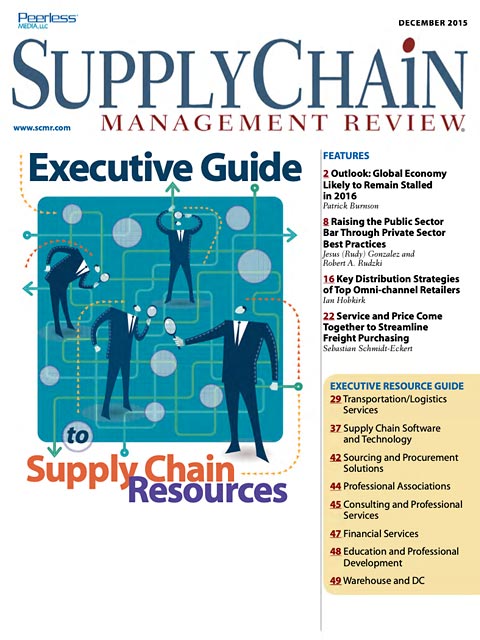Sorry, but your login has failed. Please recheck your login information and resubmit. If your subscription has expired, renew here.
December 2015
It’s December, and time once again for our annual Executive Guide to Supply Chain Resources. This is a comprehensive guide to services, products, and educational opportunities targeted specifically to supply chain professionals. The editors at Supply Chain Management Review wish all of our readers a successful year to come. Browse this issue archive.Need Help? Contact customer service 847-559-7581 More options
The sustainability story of the past 20 years is powerful. But, the story, as generally told, is incomplete. Sustainability emerged in the 1990s as the “right thing to do.” Given the earth’s finite resources and growing population, no one could argue against the Brundtland Commission’s definition of sustainable economic development as “development that meets the needs of current generations without compromising the ability of future generations to meet their own needs.” Grounded in such compelling logic, the sustainability view was quickly codified as the “triple bottom line” (see Exhibit 1 Panel A), which argued that decision makers should place equal weight on the three Ps: people, planet, and profit.
Throughout the 1990s and early 2000s, momentum for sustainable decision-making grew. Companies embraced ecological and social performance, touting sustainability efforts to stakeholders. In the consumer space, a new demographic—LOHAS (lifestyle of health and sustainability)—emerged. By 2005, Walmart’s CEO, Lee Scott, championed sustainability, proclaiming:
“Our environmental goals at Walmart are simple and straightforward:
1. to be supplied 100 percent by renewable energy;
2. to create zero waste; and
3. to sell products that sustain our resources and environment.
These goals are both ambitious and aspirational.”
Notably, Lee Scott’s three-pronged strategy revealed sustainability as a supply chain phenomenon. Renewable energy, zero waste, and sustainable-product initiatives don’t just influence supply chain behaviors; rather, obtaining real results requires innovative supply chain collaboration.
 |
This complete article is available to subscribers
only. Click on Log In Now at the top of this article for full access. Or, Start your PLUS+ subscription for instant access. |
SC
MR
Sorry, but your login has failed. Please recheck your login information and resubmit. If your subscription has expired, renew here.
December 2015
It’s December, and time once again for our annual Executive Guide to Supply Chain Resources. This is a comprehensive guide to services, products, and educational opportunities targeted specifically to supply chain… Browse this issue archive. Access your online digital edition. Download a PDF file of the December 2015 issue.
 |
Download Article PDF |
The sustainability story of the past 20 years is powerful. But, the story, as generally told, is incomplete. Sustainability emerged in the 1990s as the “right thing to do.” Given the earth's finite resources and growing population, no one could argue against the Brundtland Commission's definition of sustainable economic development as “development that meets the needs of current generations without compromising the ability of future generations to meet their own needs.” Grounded in such compelling logic, the sustainability view was quickly codified as the “triple bottom line” (see Exhibit 1 Panel A), which argued that decision makers should place equal weight on the three Ps: people, planet, and profit.
Throughout the 1990s and early 2000s, momentum for sustainable decision-making grew. Companies embraced ecological and social performance, touting sustainability efforts to stakeholders. In the consumer space, a new demographic—LOHAS (lifestyle of health and sustainability)—emerged. By 2005, Walmart's CEO, Lee Scott, championed sustainability, proclaiming:
“Our environmental goals at Walmart are simple and straightforward:
to be supplied 100 percent by renewable energy;
to create zero waste; and
- to sell products that sustain our resources and environment.
These goals are both ambitious and aspirational.”
Notably, Lee Scott's three-pronged strategy revealed sustainability as a supply chain phenomenon. Renewable energy, zero waste, and sustainable-product initiatives don't just influence supply chain behaviors; rather, obtaining real results requires innovative supply chain collaboration.
 |
SUBSCRIBERS: Click here to download PDF of the full article. |
SC
MR

Latest Supply Chain News
- How S&OP provides the answer to in-demand products
- AI, virtual reality is bringing experiential learning into the modern age
- Humanoid robots’ place in an intralogistics smart robot strategy
- Tips for CIOs to overcome technology talent acquisition troubles
- There is still work to do to achieve supply chain stability
- More News
Latest Podcast

 Explore
Explore
Topics
Latest Supply Chain News
- How S&OP provides the answer to in-demand products
- AI, virtual reality is bringing experiential learning into the modern age
- Humanoid robots’ place in an intralogistics smart robot strategy
- Tips for CIOs to overcome technology talent acquisition troubles
- There is still work to do to achieve supply chain stability
- Blooming success: The vital role of S&OE in nurturing global supply chains
- More latest news
Latest Resources

Subscribe

Supply Chain Management Review delivers the best industry content.

Editors’ Picks





